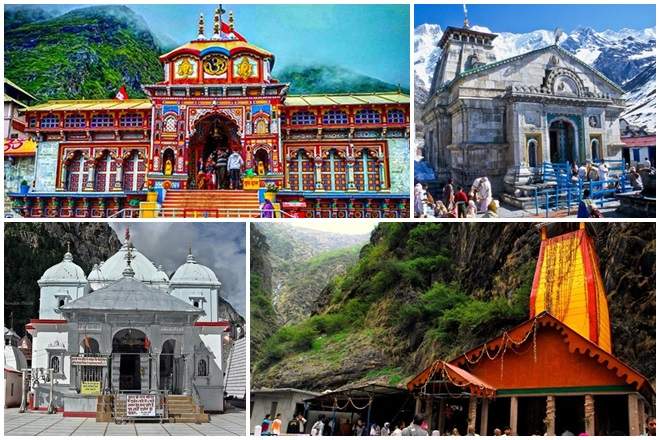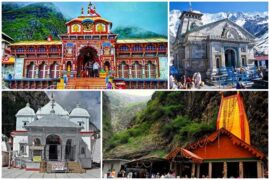Chardham Yatra Package From Haridwar
Chardham Yatra Tour Package From Haridwar– To visit the four most famous Hindu pilgrimage sites in Uttarakhand is considered extremely auspicious. The four Hindu shrines are Yamunotri (the source of river Yamuna), Gangotri (the source of river Ganges), Kedarnath (the abode of Lord Shiva), and Badrinath (the abode of Lord Vishnu). These pilgrimages are revered as Chota Char Dham in Hindu culture.
Chardham Yatra Haridwar
Chardham in Uttarakhand is one of the most revered pilgrimage sites of India. It comprises 4 Dhams namely Badrinath, Kedarnath, Gangotri, and Yamunotri. Chardham Yatra is the journey to these 4 Dhams. This journey will be a lifetime experience for you as the journey is full of adventure and religious feelings also. Char Dham Yatra in Uttarakhand is a lifetime experience.
Chardham Yatra Itinerary from Haridwar
11 NIGHTS -12 DAYS
Destination Covers: Delhi→Haridwar (1N)→Barkot (2N)→Uttarkashi (2N)→Guptkashi (2N)→ Badrinath (2N)→ Rudraprayag (1N)→ Rishikesh (1N)→ Delhi
Chardham Package From Haridwar Details ( Chardham Yatra Itinerary from Haridwar)
Day 01: Dehradun – Rishikesh (40kms drive 2hrs)
- Morning upon Arrival at the Airport/railway station/pick up point meet our representative and drive to Rishikesh, arrival Rishikesh check in Hotel.
- Later you shall take a tour to Rishikesh Temples & local Sightseeing – Laxman Jhulla, Ram Jhulla, Bharat Mandir, Shivananda Ashram, Parmarth Ashram. Overnight stay at Haridwar. (D)
- Rishikesh: Upstream on the banks of the Ganga where it is met by the Chandrabhaga is the holy town of Rishikesh.
- Literally, Rishi’s (holy man) locks, this small town is the point where the holy Ganges crashes down in full glory onto huge boulders and creates long stretches of white sandy beaches.
- The banks are lined with ashrams, where saints and holy men rested before beginning their arduous pilgrimage up into the snow-covered land of the gods.
- Rishikesh is essentially a combination of five different districts- Rishikesh the commercial center, Muni-ki-Reti in the quiet suburbs, Shivananda Nagar to the north, Lakshmanjhula with its holy shrines, and Swarg Ashram where most of the ashrams are located.
Day 02: Rishikesh – Barkot (220kms/7-8hr)
- Depart from Rishikesh early morning continue your journey and reach Barkot in the evening upon arrival check in to the hotel, Dinner, and overnight at the hotel.

Day 03:Barkot – Yamunotri – Barkot 36kms drive & 6kms Trek (one side)
- Drive to Jankichatti / Phoolchatti, trek start from here to Yamunotri (6kms). Either by walk or by horse or by Doli at own cost. Arr.
- Yamunotri, One can cook rice by packing it in a cloth and dipping it in the hot water of the hot Kund. Pilgrims take this cooked rice home as “Prasad”. Here near the temple “Pooja” can be offered to Divya Shila,.
- After taking bath in Jamunabai Kund’s warm water and having “Darshan” of pious “Yamunaji” returning to Jankichatti. Later drive back to Barkot. Overnight stay at Hotel. (B, D)
- Yamunotri Temple: Maharani Guleria of Jaipur built this temple in the 19th Century. It was destroyed twice in the present century and rebuilt again.
- Surya Kund: There are a number of thermal springs in the vicinity of the temple, which flows into the numerous pools. The most important of these is the Surya Kund.
- Divya Shila: A rock pillar, worshipped before entering the Yamunotri Temple.
Day 04: Barkot – Uttarkashi (100kms/4hr)
- After a relaxed breakfast, leave for Uttarkashi, a drive of 100 km. En-route visit Prakateshwar Cave, on arrival Uttarkashi, Check-in at the Hotel Evening visit Vishvanath Temple, Overnight stay at the hotel. (B, D)
- Uttarkashi: Situated at the bank of river Bhagirathi. The temple of Lord Vishwanath is located here where a massive iron trident is erected.

Day 05: Uttarkashi – Gangotri – Uttarkashi (100kms/3-4 each side)
- Early Morning drive to Gangotri (3048 mt), en route we enjoy picturesque Harsil village, Bhagirathi River, and the most magnificent view of the Himalayas. After Gangotri Darshan, we return to Uttarkashi. Overnight stay at Uttarkashi. (B, D)
- Gangotri Temple: Gangotri temple is 18th Century temple dedicated to Goddess Ganga. It is located near a sacred stone where king Bhagirath worshipped Lord Shiva. Ganga “Deva Yagna” here to atone the death of their kinsmen in the epic battle of Mahabharat. The temple is an exquisite 20ft. high structure made of white granite.
- Submerged Shivling: Submerged in the river, this natural rock Shivling is the place, according to mythology Lord Shiva sat when he received the Ganga in his matted lock. It is visible in the winter months when the water level decreases.
- Kedar Ganga Sangam: Around 100 Yards from the Ganga Temple flows the river Kedar Ganga. Starting from the Kedar Valley, this river meets the Bhagirathi on its left bank.
Day 06: Uttarkashi – Guptkashi / Rampur (220kms/8-9hr)
After a very early breakfast, leave for Guptkasi. a late lunch is scheduled en Route. After lunch, continue your journey and today you see the Beautiful River Mandakini. Travel alongside the River Mandakini to reach Guptakashi in the Evening, Overnight Stay at Hotel.

Day 07: Guptkashi – Kedarnath – Gutpkashi /Rampur
- After breakfast at the Camp-Resort, you will fly to Kedarnath. Due to massive floods last two year ago all accommodation facilities in Kedarnath have been damaged.
- Night halt will not be provided in Kedarnath, instead, we will offer night halt facilities in the Guptkashi area.
- Kedarnath Temple: The Kedarnath shrine, one of the 12 jyotirlingas of Lord Shiva, is a scenic spot situated, against the backdrop of the majestic Kedarnath range.
- Kedar is another name of Lord Shiva, the protector, and the destroyer. According to legend, the Pandavas after having won over the Kaurava in the Kurukshetra war felt guilty of having killed their own brothers and sought the blessings of Lord Shiva for redemption.
- He eluded them repeatedly and while fleeing took refuge at Kedarnath in the form of a bull. On being followed he dived into the ground, leaving his hump on the surface.
- The remaining portions of Lord Shiva appeared at four other places and are worshipped there as his manifestations.
- The arms appeared at Tungnath, the face at Rudranath, the belly at Madhmaheshwar, and his locks (hair) with the head at Kalpeshwar. Kedarnath and the four above-mentioned shrines are treated as Panch Kedar.
- Guests can get in touch with our local partner to avail of special entry or to perform any special puja at Kedarnath with the temple committee office.
- Cost for any such arrangements will be paid directly by the passengers to the local partner of Dham Yatra.
Day 08: Guptkashi – Joshimath (150kms/6hr)
After Breakfast leave for Joshimath. Check-in Hotel & If time permits visit Joshi Math Temple Dinner & Overnight Stay.

Day 09: Joshi Math to Badrinath ( 50 km )
- The morning after breakfast visit Badrinath around Overnight in Badrinath ). There are other interesting sightseeing spots like Mana, Vyas Gufa, Maatamoorti, Charanpaduka, Bhimkund, and the “Mukh” of the Saraswati River. Just within the three km of Badrinathjee.
- Badrinath: Cradled in the twin Mountain ranges of Nar and Narayan are the holies of the four main shrines-Badrinath along the left bank of Alaknanda with the towering Neelkanth peak as the splendid backdrop.
- Once the spot was carpeted with “Badri” or wild berries and hence was famous as Badri van. Legend has it when the Ganga was requested to descend to earth to help suffering humanity, the earth was unable to withstand the force of its descent, There for the mighty Ganga was split into 12 holy channels,.
- Alaknanda was one of them that later became the abode of Lord Vishnu or Badrinath Ji. Badrinath one of the ‘Four Dhams’ is one of the most celebrated pilgrimage spots of the country and is situated at an elevation of 3,133 meters, This revered spot was once carpeted with wild berries.
- Thus the place got the name “Badri van”, meaning “forest of berries”.
- Tapt Kund: Natural thermal springs on the bank of the river Alaknanda, where it is customary to bathe before entering the Badrinath temple.
- Narad Kund: A recess in the river, near Tapt Kund, forming a pool from where the Badrinath idol was recovered.
- Brahama Kapal: A flat platform on the bank of river Alaknanda. Hindus perform propitiating rites for their deceased ancestors.
- Mana Village: Inhabited by an Indo-Mongolian tribe, it is the last Indian village before Tibet.
- Bhim Pul: On the other side of Mana village, a massive rock forming a natural bridge, lies over the roaring Saraswati river.
- It presents a spectacular view of water thundering down through the narrow passage under the rock and is believed to have been placed there by Bhim, the second eldest among the five Pandava brothers.
- Vyas Gufa (cave): Near Mana Village, this is a rock cave where Ved Vyas is believed to have composed the Mahabharata and the puranic commentaries.
Day 10: Badrinath – Joshimath – Pipalkoti – Rudraprayag (180kms/6-7hr)
- Early morning, pilgrims after having a bath in the Taptkund have the Darshan of Badrivishal. Brahamakapal is significant for Pinddan Shraddh of ancestors (Petros Later drive back to Joshimath – Pipalkoti – Rudraprayag. Check-in Hotel. Overnight stay in Rudraprayag. (B, D)
- Joshimath: is situated on the slopes above the confluence of Alaknanda and Dhauliganga. Of the four ‘Maths’ established by Adi Shankaracharya.
- Joshimath is in the Badrinath to Joshimath and installed in the temple for people to worship. There are many temples in the township most important is the temple of Nar Singh in the commotion of Lord Vishnu.
- The left arm of this deity is with time and the popular belief holds that the day the arm completely withers Badrinath valley will cease to exist and the Gods will transfer the residence into the neighboring Niti Valley at Bhavishya Badri.
- Joshimath is connected by regular bus service to Rishikesh, Haridwar, Badrinath, and many other centers in the region.
- Rudraprayag: It is the confluence of river Mandakini and river Alaknanda.
Day 11: Rudraprayag –Rishikesh (140 km/ 5 hrs)
- After breakfast at the resort, you will Shivpuri. Here you may opt to enjoy some adventure activities like River rafting, etc. on your own. Take an excursion to Rishikesh.
- The ‘place of sages’ is a celebrated spiritual town on the bank of Ganga and is surrounded by the Shivalik range of the Himalayas on three sides. It is said that when Raibhya Rishi did hard penances, God appeared by the name of ” Hrishikesh ” and this area henceforth came to be known as Rishikesh.
- Ganga Aarti Ram Jhula & Laxman Jhula & Shopping. Overnight in Rishikesh.
Day 12: Rishikesh – Delhi (250 km/ 6-7 hrs)
- Breakfast at Hotel- Drive to New Delhi ( Airport / Hotel / Railway Station ) for onwards Journey.



Comments are closed.